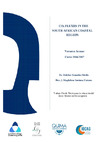Identificador persistente para citar o vincular este elemento:
https://accedacris.ulpgc.es/jspui/handle/10553/55940
| Título: | CO2 fluxes in the South African Coastal Region | Autores/as: | Arnone, Veronica | Director/a : | González Dávila, Melchor Santana Casiano, Juana Magdalena |
Clasificación UNESCO: | 230305 Carbono | Palabras clave: | CO2 en el océano | Fecha de publicación: | 2017 | Resumen: | The air-sea exchange of CO2, its distribution and trends in the South African continental shelf were described with measurement made using a volunteer observing ship (VOS) that operated along the QUIMA-VOS line over 6 years (2005-2008 and 2011-2012) and provided 30 journeys. Seawater properties, strongly controlled by oceanographic dynamic, showed a complex pattern of distribution between Cape Town and Durban. Three different upwelling cells were identified and dominated the regional variability, together with the presence of eddies, filaments and the core of Agulhas Current. From west to east the variation of fugacity (fCO2) follows the temperature increase and the incorporation of South West Indian Central Water onto the shelf, resulting in oversaturated (>600 µatm) and undersaturated (~215 µatm) waters, affected by the presence of organisms that uptake CO2. Seasonal and interannual cycles for SST, salinity, wind, fCO2 and FCO2 showed a longitudinal dependent trend. From 2005 to 2012, salinity, wind, fCO2 and FCO2 decreased while SST increased, the magnitude depending on the region. From 18º25’E to 20º15’E (West Region) surface water was undersaturated and presented an averaged flux of -2.06 ± 2.10 mol m-2 yr-1. For the South Region (20º15’E28º30’E) a value of -2.33 ± 1.58 mol m-2 yr-1 is reached, while between 28º30’E and 31º15’E (East Region) the averaged flux is -1.19 ± 1.11 mol m-2 yr-1. The studied area acted as a sink with a mean value of -2.04 ± 1.65 mol m-2 yr-1. From Cape Town to Durban, between 2005 and 2012 and assuming that FCO2 obtained with the harmonic fit was uniform over the shelf considered (1490·108 m2), the South African coastal region uptakes 3.66 ± 0.10 Tg C yr-1 with an interannual increase of 0.04 ± 0.10 Tg C yr-1. | Departamento: | Departamento de Química | Facultad: | Facultad de Ciencias del Mar | Titulación: | Máster Universitario en Oceanografía por la Universidad de Cádiz, la Universidad de Las Palmas de Gran Canaria y la Universidad de Vigo | URI: | https://accedacris.ulpgc.es/handle/10553/55940 |
| Colección: | Trabajo final de máster |
En el caso de que no encuentre el documento puede ser debido a que el centro o las/os autoras/es no autorizan su publicación. Si tiene verdadero interés en el contenido del mismo, puede dirigirse al director/a o directores/as del trabajo cuyos datos encontrará más arriba.
Vista completaVisitas 10
65
actualizado el 10-ene-2026
Descargas
47
actualizado el 10-ene-2026
Google ScholarTM
Verifica
Comparte
Exporta metadatos
Los elementos en ULPGC accedaCRIS están protegidos por derechos de autor con todos los derechos reservados, a menos que se indique lo contrario.
